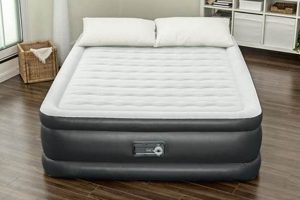A specialized support surface, designed to redistribute pressure and manage moisture, is frequently utilized in healthcare settings. This type of mattress incorporates alternating inflation and deflation cycles within its air cells, providing cyclical pressure relief to vulnerable areas of the patient’s body. Simultaneously, the “low air loss” feature allows for a continuous flow of air through small perforations in the mattress surface, helping to wick away moisture and maintain a dry microclimate. For instance, a patient at high risk for pressure ulcers might benefit from the use of such a surface to improve circulation and reduce skin maceration.
The significance of this technology lies in its ability to aid in pressure ulcer prevention and management, improve patient comfort, and reduce the risk of skin breakdown. Historically, static support surfaces offered limited pressure relief, leading to increased incidence of pressure injuries. The advent of dynamic support systems, incorporating both pressure redistribution and moisture management, represents a substantial advancement in patient care. These advancements can contribute to decreased healthcare costs associated with treating pressure ulcers, as well as improved patient outcomes and quality of life.
The following sections will delve into the specific mechanisms of action, appropriate patient selection criteria, and practical considerations regarding the use of these advanced support surfaces in various clinical settings. Furthermore, different types and features available will be discussed.
Guidance for Optimal Utilization
Effective application requires a thorough understanding of its capabilities and limitations. These guidelines outline best practices for maximizing the benefits of this specialized support surface.
Tip 1: Patient Selection: This surface is most appropriate for individuals at moderate to high risk of developing pressure injuries. Risk assessment tools, such as the Braden Scale, should be utilized to identify suitable candidates.
Tip 2: Proper Inflation: Ensure the surface is inflated to the manufacturer’s recommended pressure. Insufficient inflation reduces its pressure redistribution capabilities, while over-inflation can compromise patient comfort.
Tip 3: Regular Inspection: Routinely inspect the surface for any signs of damage, such as tears or leaks. A compromised surface will not provide adequate support and may pose a safety hazard.
Tip 4: Moisture Management: While the low air loss feature aids in moisture control, diligent skin care remains paramount. Employ appropriate skin cleansing and moisturizing practices to prevent maceration.
Tip 5: Repositioning Schedule: Even with the pressure redistribution properties of this surface, adherence to a regular repositioning schedule is crucial. Frequent repositioning further minimizes sustained pressure on bony prominences.
Tip 6: Education: Provide comprehensive education to both patients and caregivers regarding the purpose, operation, and maintenance of this equipment. Informed use enhances adherence and optimizes outcomes.
Tip 7: Weight Limit Adherence: Ensure the patient’s weight does not exceed the maximum weight capacity specified by the manufacturer. Exceeding this limit can damage the mattress and compromise its therapeutic efficacy.
Consistent application of these guidelines will contribute to enhanced pressure ulcer prevention, improved patient comfort, and overall reduction in healthcare costs associated with pressure injury management.
The subsequent sections will explore specific clinical applications and considerations for integrating this technology into various care settings.
1. Pressure Redistribution
Pressure redistribution is a critical function in preventing and managing pressure injuries, particularly in immobile or vulnerable patients. The design and functionality of the specialized mattress are intrinsically linked to its capacity to effectively redistribute pressure away from bony prominences and high-risk areas.
- Cyclical Inflation and Deflation
The alternating inflation and deflation of air cells within the mattress create a dynamic support surface. This cyclical change in pressure points reduces the duration and intensity of pressure applied to any single area of the patient’s body. For example, if a patient is lying on their sacrum, the air cells beneath that area will periodically deflate, relieving pressure and allowing for improved blood flow. This mechanism is crucial for preventing ischemia and tissue damage.
- Immersion and Envelopment
A properly functioning system allows the patient to sink slightly into the mattress (immersion), thereby increasing the surface area over which their weight is distributed. Simultaneously, the mattress conforms to the contours of the body (envelopment), minimizing pressure concentrations on bony prominences such as the heels and elbows. Without adequate immersion and envelopment, pressure will remain localized, increasing the risk of tissue breakdown.
- Customizable Pressure Settings
Many surfaces offer adjustable pressure settings to accommodate individual patient needs. This allows healthcare providers to tailor the support surface to the patient’s weight, body habitus, and specific risk factors. For instance, a heavier patient might require higher inflation pressures to achieve adequate pressure redistribution, while a lighter patient might benefit from lower pressures to maximize comfort and minimize the risk of bottoming out.
- Interface Pressure Reduction
Interface pressure refers to the pressure exerted between the patient’s skin and the support surface. A primary goal of pressure redistribution is to minimize this interface pressure, particularly over bony prominences. By effectively distributing the patient’s weight across a larger surface area, these surfaces can significantly reduce interface pressure, thereby decreasing the risk of pressure injury development.
In summary, the pressure redistribution capabilities of the mattress are fundamental to its therapeutic efficacy. Through cyclical inflation, immersion, envelopment, and customizable pressure settings, the system minimizes sustained pressure on vulnerable areas, promoting tissue perfusion and aiding in the prevention of pressure injuries. The low air loss feature complements this function by managing moisture, further reducing the risk of skin breakdown.
2. Moisture Control
The efficacy of a specialized support surface in pressure injury prevention is intrinsically linked to its ability to manage moisture. Excessive moisture on the skin, originating from perspiration, incontinence, or wound exudate,
significantly increases the risk of skin maceration. Macerated skin is more susceptible to friction and shear forces, leading to skin breakdown and pressure injury development. The integration of low air loss technology into these surfaces directly addresses this critical aspect of skin integrity.
The “low air loss” component works by continuously circulating a gentle flow of air through small perforations on the surface of the mattress. This constant airflow wicks away moisture, creating a drier microclimate between the patient’s skin and the support surface. For instance, consider a patient who is diaphoretic due to fever. Without moisture management, perspiration would accumulate, softening the skin and increasing the risk of damage. However, with low air loss, the air circulation actively evaporates the moisture, maintaining a drier skin surface. Incontinence, another common source of moisture, can similarly be mitigated through continuous air circulation, reducing the potential for skin breakdown. The effectiveness of the low air loss feature is often assessed by measuring the water vapor transmission rate (WVTR) of the mattress surface, indicating its capacity to remove moisture.
Therefore, moisture control is not merely an ancillary benefit, but an essential element of a specialized support surface. It works synergistically with pressure redistribution to create an environment conducive to skin integrity. The effectiveness of pressure redistribution is significantly enhanced when combined with proactive moisture management. By understanding this interrelationship, clinicians can make informed decisions regarding support surface selection, optimizing patient outcomes and reducing the incidence of pressure injuries. Challenges remain in managing patients with excessive or persistent moisture due to factors such as severe hyperhidrosis or profuse wound drainage, necessitating a comprehensive approach to skin care beyond the capabilities of the low air loss feature alone. This underscores the importance of combining technological solutions with diligent nursing care and appropriate skin care protocols.
3. Alternating Inflation
Alternating inflation is a core function of specialized support surfaces designed for pressure injury prevention. The cyclical nature of this feature is integral to the overall therapeutic effect and significantly enhances the mattress’s capacity to redistribute pressure effectively.
- Pressure Redistribution Dynamics
Alternating inflation creates a dynamic pressure environment beneath the patient. Air cells inflate and deflate in a timed sequence, shifting the points of contact and relieving pressure on bony prominences. A typical cycle might involve inflating cells under the sacrum while deflating cells under the heels, then reversing the pattern. This constant change prevents prolonged pressure on any single area, mitigating the risk of ischemia and tissue damage. The precise timing and pressure levels of the alternating cycle are crucial for optimal pressure redistribution and are often adjustable based on patient-specific needs.
- Microcirculation Enhancement
The cyclical pressure relief facilitated by alternating inflation promotes improved microcirculation in the skin and subcutaneous tissues. Sustained pressure compresses blood vessels, reducing blood flow and oxygen delivery to tissues. Alternating inflation allows for periodic reperfusion, restoring blood flow and nourishing tissues. This enhanced microcirculation is vital for maintaining skin integrity and preventing pressure injuries.
- Edema Reduction
In some patients, alternating inflation may contribute to edema reduction, particularly in the lower extremities. The cyclical pressure changes can assist in promoting venous return and lymphatic drainage, reducing fluid accumulation in tissues. However, this is not the primary purpose of alternating inflation, and other interventions may be necessary for patients with significant edema.
- Impact on Patient Comfort
While alternating inflation primarily serves a therapeutic purpose, it can also impact patient comfort. Some patients may find the constant changes in pressure uncomfortable or disruptive. Modern designs often incorporate features to minimize noise and vibration and allow for adjustments to cycle times and pressure levels to optimize comfort. The impact on patient sleep should also be considered, and adjustments made as needed.
In summary, alternating inflation is a critical component of the overall function of a specialized support surface. By creating a dynamic pressure environment, it promotes pressure redistribution, enhances microcirculation, and may contribute to edema reduction. While patient comfort must also be considered, the therapeutic benefits of alternating inflation in preventing pressure injuries are well-established and represent a significant advancement in patient care.
4. Patient Weight
Patient weight is a fundamental consideration in the selection and effective utilization of a specialized support surface. The capacity of the surface to provide adequate pressure redistribution and maintain its therapeutic benefits is directly influenced by the patient’s weight. Exceeding the manufacturer’s specified weight limit can compromise the integrity and function of the surface, potentially leading to adverse patient outcomes.
- Weight Capacity Specifications
Each surface has a maximum weight capacity determined by the manufacturer. This limit reflects the surface’s structural integrity and its ability to maintain proper inflation and pressure redistribution under load. Consistent with guidelines, healthcare providers must verify the patient’s weight and ensure it falls within the specified range for the selected surface. Failure to adhere to weight limits can result in inadequate pressure relief, bottoming out (where the patient’s bony prominences make contact with the underlying mattress frame), and damage to the surface itself.
- Pressure Redistribution Efficacy
As patient weight increases, the pressure exerted on the support surface also increases. A surface designed for a specific weight range may not effectively redistribute pressure for a heavier individual. This can lead to localized pressure concentrations on bony prominences, increasing the risk of pressure injury development. Appropriate weight-based adjustments to inflation settings may be possible on some surfaces, but exceeding the maximum weight limit invariably compromises the surface’s effectiveness.
- Mattress Durability and Longevity
Consistently exceeding the weight limit can accelerate wear and tear on the mattress, shortening its lifespan and potentially leading to premature failure. Internal components, such as air cells and pump mechanisms, may be subjected to excessive strain, resulting in leaks, malfunctions, and reduced therapeutic benefit. Maintaining compliance with weight limits is therefore essential for preserving the investment in the support surface and ensuring its continued functionality.
- Clinical Outcomes and Safety
When a surface is used outside of its specified weight range, patient safety is directly compromised. Inadequate pressure redistribution can lead to pressure injury development, increased pain, and prolonged hospital stays. Fur
thermore, a damaged or malfunctioning surface can pose a safety hazard, potentially leading to falls or other injuries. Careful weight assessment and adherence to manufacturer guidelines are crucial for ensuring both the therapeutic efficacy and the safety of the support surface.
In conclusion, patient weight is not merely a logistical consideration, but a critical determinant of the effectiveness and safety of these surfaces. Careful weight assessment, adherence to manufacturer specifications, and regular monitoring of the surface’s condition are essential components of best practice. This is a crucial element for preventing the development of pressure injuries.
5. Support Surface
The selection of an appropriate support surface is a cornerstone of pressure injury prevention and management, particularly for individuals at elevated risk. The specialized mattress is a specific type of advanced support surface designed to address the multifaceted challenges of pressure redistribution, moisture control, and microclimate management. The characteristics of the support surface are crucial determinants of its therapeutic efficacy.
- Material Composition
The materials used in the construction of the support surface influence its ability to conform to the patient’s body and redistribute pressure. Materials with high elasticity and low stiffness are preferred, as they can better envelop bony prominences and minimize pressure concentrations. For example, viscoelastic foam or gel-infused materials can provide superior pressure redistribution compared to traditional innerspring mattresses. In the context of the low air loss alternating pressure mattress, the air cells themselves and the material covering them must be durable, biocompatible, and capable of supporting the patient’s weight while facilitating air flow.
- Surface Design and Configuration
The design of the support surface, including its contours, channels, and cell configuration, significantly impacts its performance. Surfaces with contoured designs can better accommodate the body’s natural curves and reduce pressure points. Channel designs can promote airflow and reduce moisture accumulation. In low air loss alternating pressure systems, the arrangement and size of the air cells, as well as the location and density of the air loss perforations, are carefully engineered to optimize pressure redistribution and microclimate control. For instance, a mattress with smaller, more numerous air cells may provide more targeted pressure relief compared to one with fewer, larger cells.
- Static vs. Dynamic Properties
Support surfaces can be broadly categorized as static or dynamic. Static surfaces provide consistent support and pressure redistribution without active mechanisms, relying primarily on material properties. Dynamic surfaces, such as the specialized mattress, incorporate active mechanisms, such as alternating inflation and deflation, to cyclically redistribute pressure. The choice between static and dynamic surfaces depends on the patient’s risk factors, mobility, and overall clinical condition. A patient at high risk for pressure injuries, or one with existing pressure injuries, may benefit more from a dynamic surface like the low air loss alternating pressure mattress, while a patient at lower risk may be adequately managed with a static surface.
- Interface Pressure Management
The primary goal of any effective support surface is to minimize interface pressure, the pressure exerted between the patient’s skin and the surface. High interface pressure is a key contributor to pressure injury development. Different support surfaces vary in their ability to reduce interface pressure, depending on their material composition, design, and dynamic properties. The alternating pressure feature of a specialized mattress is specifically designed to cyclically reduce interface pressure on different areas of the body, providing periods of relief that promote tissue perfusion and prevent ischemia. Regular monitoring of interface pressure using specialized sensors can help to optimize support surface selection and pressure management strategies.
These facets of support surface design and function are directly relevant to the selection and utilization of the specialized mattress. The material composition, surface design, static vs. dynamic properties, and interface pressure management capabilities of the mattress all contribute to its therapeutic efficacy in pressure injury prevention and management. Understanding these interrelationships is essential for healthcare providers to make informed decisions about support surface selection and to optimize patient outcomes.
Frequently Asked Questions
This section addresses common inquiries regarding the use, function, and maintenance of a low air loss alternating pressure mattress, a specialized support surface designed for pressure injury prevention.
Question 1: What are the primary benefits of a low air loss alternating pressure mattress compared to a standard hospital mattress?
A low air loss alternating pressure mattress provides two key benefits: pressure redistribution and moisture management. The alternating inflation and deflation cycles relieve pressure on bony prominences, while the low air loss feature wicks away moisture, reducing the risk of skin maceration. A standard hospital mattress lacks these features, potentially increasing the risk of pressure injury development.
Question 2: How does the alternating pressure function of the mattress work?
The alternating pressure function operates through a system of air cells that inflate and deflate in a sequential pattern. This cyclical change in pressure points reduces the duration and intensity of pressure on any given area of the patient’s body, promoting blood flow and preventing tissue ischemia. The specific timing and pressure levels are typically adjustable based on patient needs.
Question 3: What is the purpose of the “low air loss” feature?
The low air loss feature involves a continuous flow of air through small perforations in the mattress surface. This airflow wicks away moisture from the patient’s skin, creating a drier microclimate and reducing the risk of skin maceration, a significant contributor to pressure injury development.
Question 4: How is the mattress properly cleaned and disinfected?
Cleaning and disinfection procedures should adhere to the manufacturer’s guidelines. Generally, a mild detergent and disinfectant solution are used to wipe down the surface of the mattress. It is crucial to ensure the surface is thoroughly dried before use to prevent moisture buildup. Harsh chemicals or abrasive cleaners should be avoided, as they can damage the mattress material.
Question 5: What factors should be considered when selecting a low air loss alternating pressure mattress for a specific patient?
Factors to consider include the patient’s weight, risk of pressure injury development (as assessed by a validated risk assessment tool), mobility level, and presence of existing pressure injuries. The mattress’s weight capacity, pressure adjustment options, and low air loss capabilities should align with the patient’s specific needs.
Question 6: What are the potential contraindications for using a low air loss alternating pressure mattress?
While generally safe, there are a few potential contraindications. These may include patients with unstable spinal
fractures, certain types of traction, or conditions where movement or instability is undesirable. Consultation with a healthcare professional is recommended to determine the suitability of the mattress for individual patients.
These FAQs provide a concise overview of key considerations related to the low air loss alternating pressure mattress. Appropriate implementation, maintenance, and patient selection are paramount to maximize its benefits in pressure injury prevention.
The subsequent section will focus on case studies and real-world applications of this technology in various clinical settings.
Conclusion
The preceding sections have presented a comprehensive overview of the low air loss alternating pressure mattress, a specialized support surface designed to mitigate the risk of pressure injuries. Exploration has encompassed its mechanisms of action, including pressure redistribution through alternating inflation and deflation, and moisture management via low air loss technology. Crucial considerations such as patient selection, weight capacity adherence, and proper maintenance protocols have been addressed.
Continued vigilance in pressure injury prevention remains paramount. Healthcare facilities must prioritize the appropriate implementation and monitoring of these support surfaces, incorporating them as part of a multifaceted approach to skin integrity management. The ultimate goal is to reduce patient suffering, improve clinical outcomes, and minimize the economic burden associated with pressure ulcer development.







